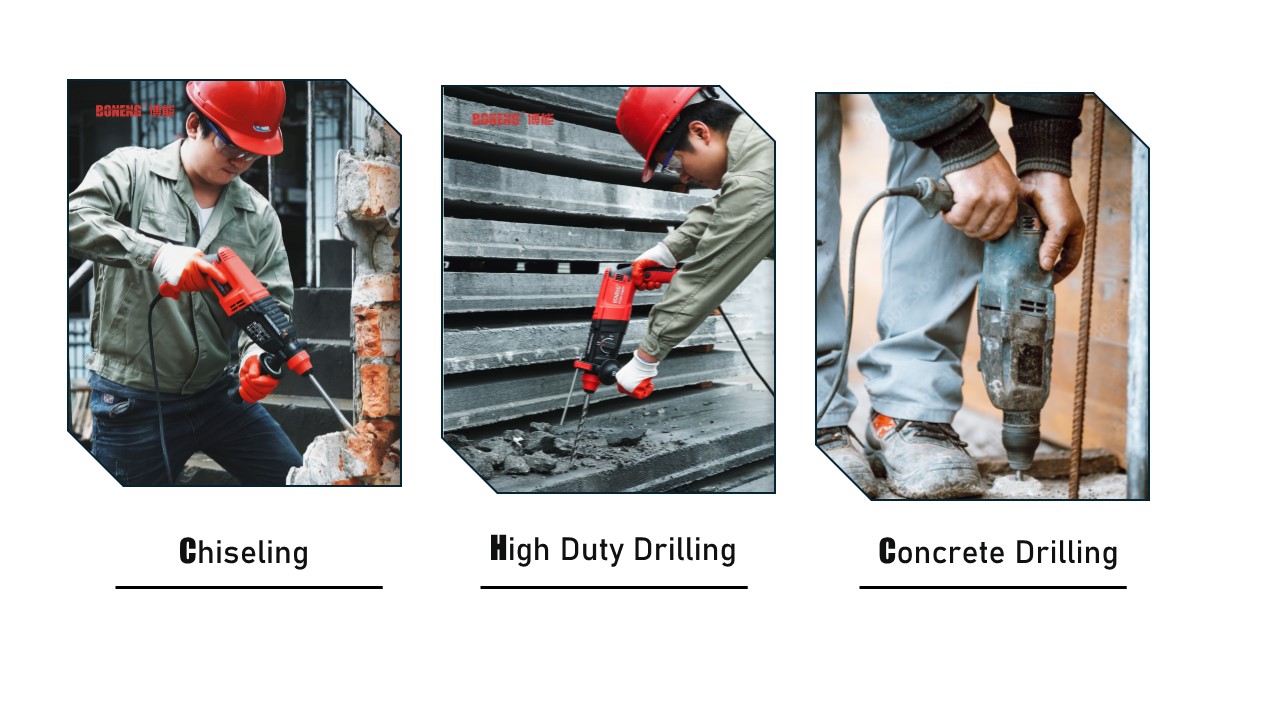What is the difference between a SDS Drill and a Hammer Drill?
2024-04-13 | Blogs

Intended Use (Applications)
SDS Rotary Hammer:
- Concrete Drilling: SDS rotary hammers excel at drilling holes in concrete, brick, stone, and other masonry materials. They are widely used in construction, renovation, and demolition projects.
- Chiseling: With specialized chisel attachments, SDS rotary hammers can perform tasks such as chipping, scaling, and breaking concrete and masonry surfaces.
- Heavy-Duty Drilling: SDS rotary hammers are ideal for drilling large diameter holes in tough materials, making them suitable for tasks like installing anchor bolts, rebar, and structural fasteners.

Hammer Drill:
- General-Purpose Drilling: Hammer drills are versatile tools suitable for drilling holes in various materials, including wood, metal, plastic, and some masonry surfaces.
- Light Construction Work: Hammer drills are commonly used for DIY projects, light construction tasks, and home improvement projects that involve drilling holes for mounting fixtures, running wires, and installing hardware.
- Precision Drilling: Hammer drills offer more control and precision compared to SDS rotary hammers, making them suitable for tasks that require accuracy and finesse, such as woodworking and cabinetmaking.

Different Structures
1. Chuck Mechanism:
- Hammer drills typically feature a keyless chuck or a standard chuck that requires tightening to hold the bit in place.
- SDS drills use a specialized chuck system known as SDS (Slotted Drive System) or SDS-Plus, which allows for quick and easy bit changes without the need for tightening.

2. Bit Compatibility:
- Hammer drills are compatible with standard round shank drill bits, masonry bits, and sometimes with chisel attachments for light chiseling tasks.
- SDS drills accept SDS drill bits, which have a special shank design with slots that allow them to be quickly inserted and removed from the chuck without any twisting. SDS drills are also compatible with SDS chisel attachments for heavy-duty chiseling and demolition work.

Different Mechanisms
(for Delivering Impact Force to the Drill Bit)
A hammer drill is simply a type of drill. Where a regular drill rotates the bit to drill into concrete or masonry material, a hammer drill adds a percussive action. Inside the hammer drill, a set of toothed gears engages with each other to produce a back-and-forth motion,while the bit rotates in hammering mode.
SDS drills separate the hammering action from the rotational motion of the bit. The grooves in the SDS chuck allow the bit to move freely within the chuck, absorbing much of the impact energy. This design reduces wear and tear on the drill and provides more efficient energy transfer to the bit.
In the meanwhile, the SDS chuck system and pneumatic hammer mechanism work together to provide faster drilling speeds, greater drilling power, and improved durability, especially when drilling into tough materials like concrete, stone, or masonry.

Leading Manufacturer of SDS Rotary Hammer in China
Related News
Choosing the Right Grease for Your Rotary Hammer
Rotary hammers are powerful tools designed for demanding applications in construction and masonry work. To keep these tools operating smoothly and efficiently, proper lubrication is crucial. One essential component for maintenance is the choice of grease.
What are safety rules when using a rotary hammer?
Using a rotary hammer involves handling a powerful tool that can be potentially hazardous if not used correctly. Adhering to safety rules is crucial to prevent accidents and ensure a safe working environment. Here are important safety rules when using a rotary hammer:
Unlocking the Power: What Are Rotary Hammer Drills Used For?
Rotary hammer drills have become indispensable tools in various industries and DIY projects, thanks to their versatile nature and robust capabilities. Let's delve into the details of what makes these tools so unique and the wide range of applications they serve.





